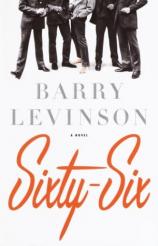Sixty-Six
Review
Sixty-Six
What is remarkable, and slightly odd, about Barry Levinson's SIXTY-SIX is that it looks at the 1960s through the wrong side of the looking glass. The usual way of looking at the past is backward, retrograde, seeing it from the perspective of what is happening now. But SIXTY-SIX sees the 1960s --- or rather, the turbulent times of the later 1960s --- as the future, rather than the past. The countercultural radicalism that is now the indelible signature of the time is, for Levinson's characters, something that is just beginning to happen to their insular Baltimore existence.
Levinson's characters come into contact with the themes of the 1960s --- Vietnam, drugs, the sexual revolution --- but they do so late in the game. SIXTY-SIX easily could be described as a "coming-of-age" novel, but that is too easy, too facile a label. The characters --- surrogates for Levinson himself and the people he knew growing up in Baltimore --- have left high school and college behind. They are already of age, dealing with the pressures of new jobs and new careers, finding their way in the world. The impact of the times hits them almost at right angles.
The narrator's Vietnam experience is not in the jungles of Southeast Asia, but in the stately and ordered tones of a local Baltimore television newsroom, hearing Uncle Walter Cronkite read casualty reports on the local news. The main antiwar protest in the novel is not violent or especially colorful, but whimsical and wry (at least until its cause is revealed). Drug use is presented not as a great countercultural moment of excess, but as a real and stark tragedy.
If SIXTY-SIX is not about the Sixties --- or not about the Sixties in how we have come to expect books about the Sixties to be --- what is it about? Largely, for Levinson, it is about Baltimore, a diner, and a circle of friends talking about the Colts, women and the way the world works. In his movies, Levinson has returned time and again to Baltimore, so it is no surprise that the city is at the beating heart of his first novel. SIXTY-SIX is a love letter to Baltimore in Levinson's youth and the characters who populated his life at the time, particularly those who hang out at a neighborhood diner.
But Levinson is honest about the situation. His portrait of Baltimore is that of a city and a time that is passing away, to be replaced by urban decay, rot and rioting. Traditions like the Ranger Al show and the Mount Washington Square flower market --- as well as the holy diner itself --- are passing away.
Baltimore will stay with the reader long after the characters are forgotten. The characters are not especially memorable or worthwhile. Even the narrator, Levinson stand-in Bobby Shine, is kind of a schlub, working at a local TV station operating the puppets for a kids' television show. The more marginal characters are the most colorful and honest, including the character who only sleeps with prostitutes and the bail bondsman who is targeted for revenge by a Colts defenseman. But the characters we are supposed to care about the most, and who have the most tragic circumstances, are not especially filled-in.
As you might expect from a movie director, SIXTY-SIX is much more visual than it is narrative. The oft-repeated images in the novel --- a child sailing through the air after a gas main explosion, another endless night at the Greek diner --- are stronger than the writing, which verges on sentimentality and then eventually speeds right past it.
SIXTY-SIX is not a bad book by any means, although it doubtless means more to Levinson than it ever will to readers. It is primarily valuable --- immensely so --- as a primer to Baltimore in 1966 --- its times, its folkways, its customs. SIXTY-SIX is chock-full of remembrances of things great and small that made up Levinson's city, told with an eye for superb detail. Maybe that's what happens when you look through the wrong side of the looking glass.
Reviewed by Curtis Edmonds on January 23, 2011
Sixty-Six
- Publication Date: September 16, 2003
- Genres: Fiction
- Hardcover: 288 pages
- Publisher: Broadway
- ISBN-10: 076791533X
- ISBN-13: 9780767915335



